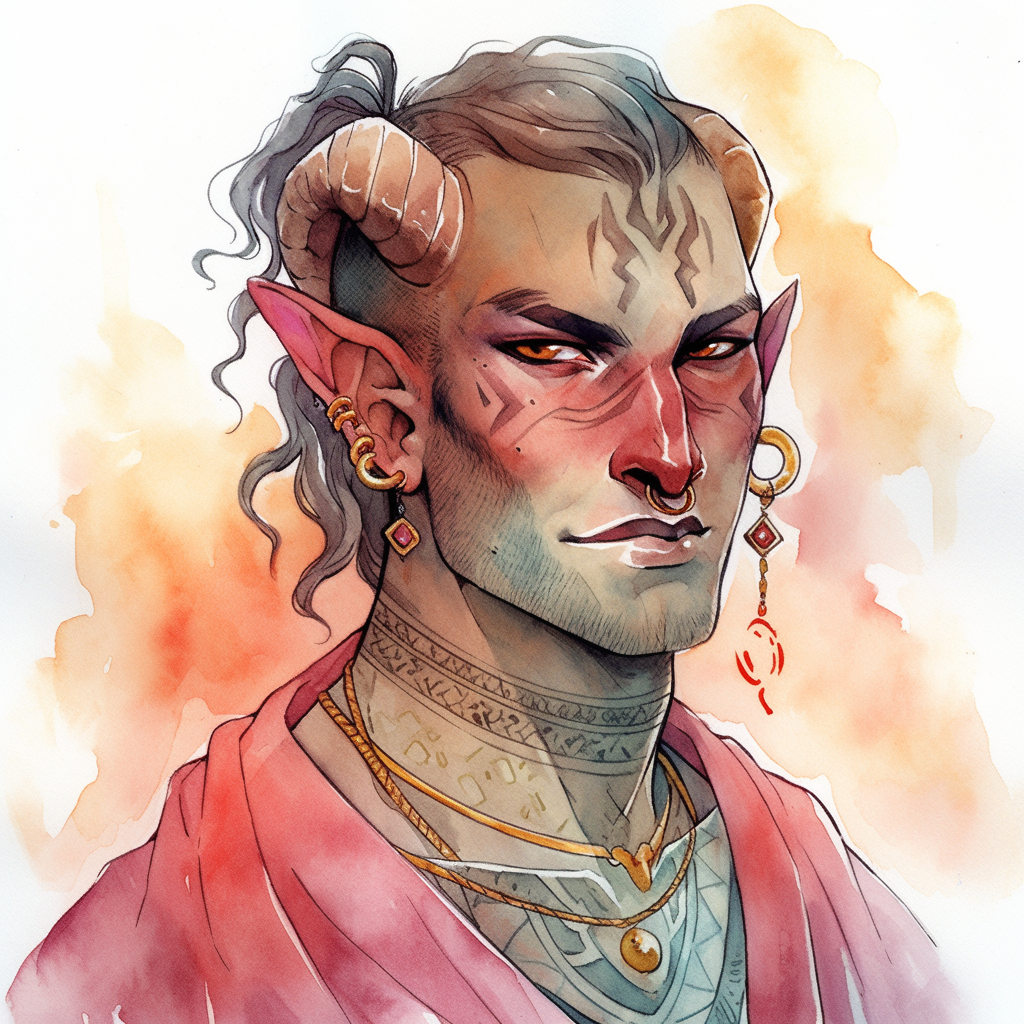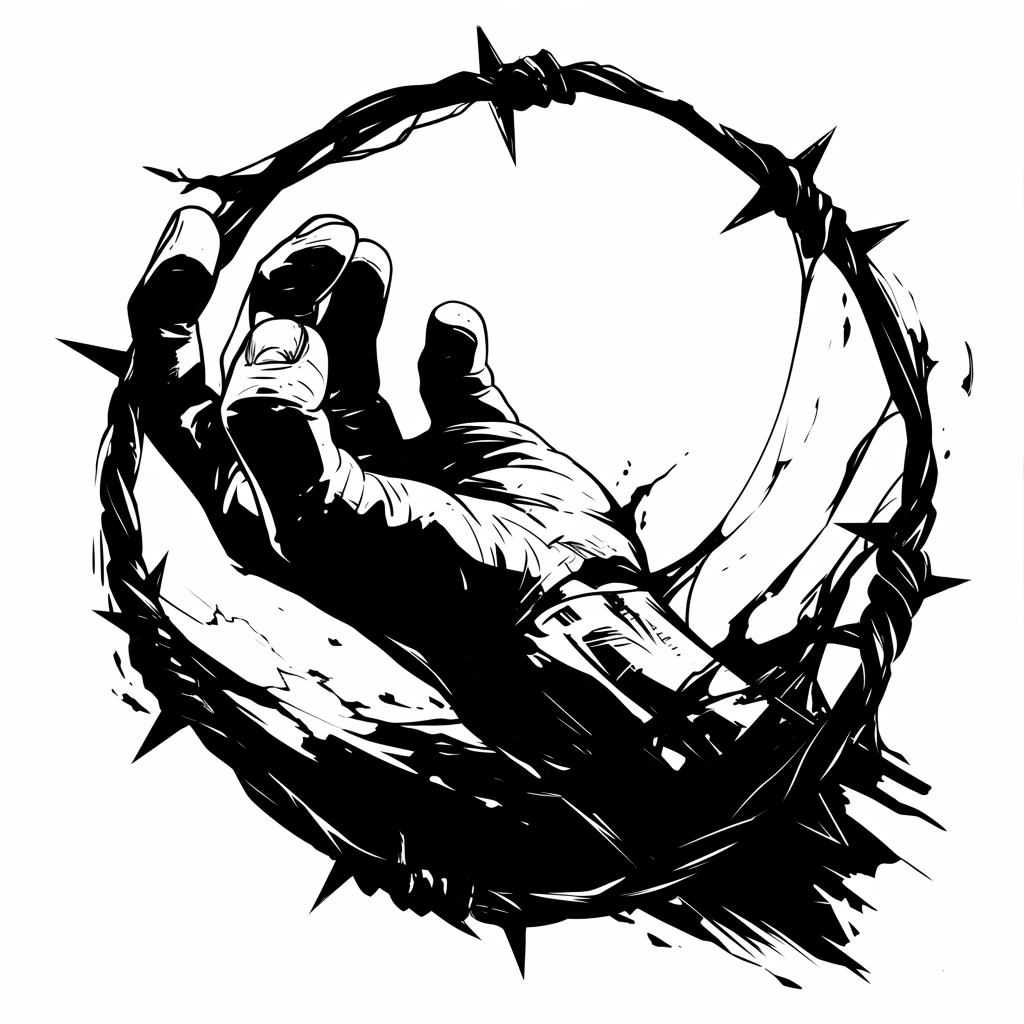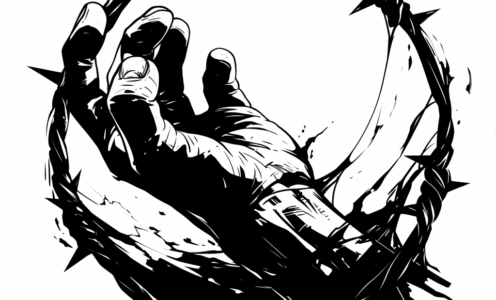The Society of Pain
Also known as: The Barbed, the Bleeders, the Martyrs
No Relation to the Lady, or so they say…
The Society of Pain ain’t, as many Primes first think, anything to do with worshipping Our Serene Lady of Pain. Berks who try that end up flayed faster than they can finish a prayer to the Fiercely Calm One. No, the Society of Pain may have been inspired by Her Graceful Gifts of Agony, but the members of this sect take great pains (ha ha!) to emphasise they ain’t religious freaks. Well, maybe they’re telling the truth. Just maybe.
In any case, the Barbed don’t have a faction headquarters in Sigil; they’re more commonly associated with Gehenna. Why anyone’d want to hail from the Fourfold Furnaces is beyond most cutters’ imaginations, but then you’ve not heard the sect’s philosophy yet, have you? I’d better stop rattling and let the mimir tell you more, then…
Be wary. Be very wary.
Those who fight with monsters should be careful,
—Factol Jalar of the Barbed
lest they thereby becomes a monster themselves”

Sect Philosophy: “Life is filled with pain berk, so why not embrace it?” ask the Martyrs. This sect believes the answer to the Multiverse is Pain, be it physical, mental or emotional. Pain’s the only proof of existence; without heartache, without pain, a berk can’t tell if they are getting burnt by a fire, bitten by a baatezu, or if they’re about to get put in the Dead Book.
Look, it ain’t that hard to understand. Pain’s the almighty teacher and the almighty ruler. For example, if you went in a room and got hit by a lightning bolt would you go back in the room? Only a barmy’d go back in the room, because it hurt. A king can’t keep a country without cutting a few berks and by doing that they tell every one they’re the rightful ruler.
Some berk’ll say “What’s this got to do with multiversal truth?” Well it ain’t that simple. The multiverse ain’t filled with pain in all places. In most of the Upper Planes there ain’t enough and in the Lower Planes there’s way too much. If you spread pain evenly through Multiverse, then it’d come to an end and we would all learn the multiversal truth.
That seems an impossible task, but there might be a way to bob the problem—to cheat the multiverse. It’s easy: all you have to do is your part, cutting people along your way and sooner or later the Multiverse will end. That doesn’t mean that the Barbed go around cutting everyone or getting cut. If that were the the case every Bleeder’d wind up in the Dead Book.
You’ve got to be careful who you cut, ‘cos if you cut the wrong person then you’ll disrupt the delicate balance of pain. The only way to tell who the right berk to cut is by getting to know them. If they’re too happy then cut ’em, if they’re full of pain then leave ’em alone, ‘cos they’ve found enough pain already.
Here’s the chant berk: if you manage to put pain in the hearts of the ones that you love, and relieve pain from the ones you hate, you’re one step further towards finding the truth than the next barmy sod.
Primary Plane of Influence: Not surprisingly, this sect is strongest in Gehenna, where pain and suffering are rampant. It’s also popular throughout the Lower Planes—where some of the nastier creatures believe that nobody’s suffering nearly enough pain. While they’ve got no formal headquarters in Sigil, members of the Barbed often gather in the underground fighting pits of the Hive Ward.
Allies and Enemies: The Sensates share a little of the philosophy of the Barbed, though there are many bones of contention about the details. It’s rare to see them working together, but it’s happened. The Fated are possibly the closest allies of the Bleeders, because of their might-makes-right heartless attitude. The Mercykillers similarly appreciate a few of the nuances of the sect, and it’s been known for Bleeders to become employed in Sigil’s prison doling out pain to criminals when the Red Death feel it’s necessary.
The Harmonium don’t like the views of the Barbed at all, and try to oppose them whenever they rear their heads in the Cage.
Eligibility: The Society of Pain’s open to all races and classes. While any alignment can join, it’s mostly evil and neutral types who chose to do so; the neutrals due to the Bleeders’ views that there is a balance that is needed to be maintained, and the evil cutters ‘cos they enjoy inflicting pain, especially if there’s a good excuse to do so. The few good members see themselves as martyrs, taking on the pain of others and helping those with terrible lives.
Benefits: Abilities learned by a Bleeder depend on the kinds of pain they specialise in. Bleeders might elect to specialise in one type of pain for their whole careers, or they might choose to learn additional techniques until they have mastered all types of pain. At fifth level, the character can learn a second pain speciality and at tenth, a third can be gained (both benefit and restriction are applied).
- Physical — In combat, the Barbed can inflict an extra 50% damage with each attack. This is temporary pain damage, which goes away 1 turn after the wound was inflicted. These Cutters often use barbed or spiked weapons, and know just how to hook the spikes in the flesh of their enemies.
- Mental — The psionic ability double pain can be used to double or halve pain, and that of inflict pain can be used also to remove pain.
- Emotional — These cutters are taught the ability of manipulation. They can manipulate a sod’s emotions verbally and by gestures: the Bleeder knows how to taunt effectively and at 5th level can create emotion in allies or enemies.
Restrictions: Because of their love for pain and martyrdom the Barbed have restrictions depending again on their specialisation:
- Physical — Can’t use armour, magical items, or any other type of equipment that lowers AC. The Martyr’s AC must be a natural AC, with only their dexterity adjustment added.
- Mental — Bleeders aren’t able to sleep well as they’re plagued by terrible dreams of pain and torture. Spellcasters require ten hours of sleep per night, and psionicists gain only one tenth of their PSP total back per hour. The characters must also pass a constitution (fitness) check each morning or suffer a –1 penalty on all rolls that day due to mental exhaustion.
- Emotional — These cutters can’t sustain a healthy relationship with other people, as they’re always trying to manipulating others around them. It seems everything they say or do is calculated to cause misery or joy… they’re creepy in the extreme.

Sectol Jalar (planar tiefling psionicist [he/him] / Sectol of the Society of Pain / LE). The burning red eyes and forked tongue on Jalar’s unassuming form mark him as one of the plane-touched. His earliest memories are of the orphanage at Sigil’s Gatehouse, where he was raised. He has no clue who his parents were, nor why he was abandoned. He was raised instead by Headmaster Trablan, the man who ran the orphanage. Trablan was an exceptionally cruel and deviant man, who enjoyed inflicting suffering on the children in his care. Jalar’s earliest memories are of the severe beatings and abuses he suffered at the hands of Trablan. Eventually, Trablan’s crimes became known to those outside of the orphanage. A new, kinder Headmaster was assigned to the orphanage, and Jalar watched as the Mercykillers fed Trablan to the wyrm. This increased Jalar’s appreciation for the Red Death, but there was yet another more event that took place on that same day that had an even greater impact on Jalar.
That was the first day Jalar personally saw the Lady of Pain.
Jalar quickly became obsessed with this enigmatic ruler. He was an intelligent lad, and had heard about the doomed cult worshipping the Lady as a power, and he did not choose to share their fate. However, everyone who knew Jalar thought he came to close to revering her in his hero worship for their own comfort. He wanted to be as much like the Lady as possible. He spent his time practising and honing his natural psionic talents to become a force to be reckoned with, just like the Lady. The closest Jalar has ever come to love in his life is through his feelings for the Lady.
Jalar’s rather formidable mental abilities brought him to the attention of some fellow Bleaker adventurers. Being raised in the Gatehouse, Jalar accepted the nihilistic philosophies of the Bleak Cabal. Some of his fellow faction members wished to make use of his talents. They had heard chant of a secret Yugoloth treasure cache on Gehenna. Offering Jalar an equal share of the findings, they set off for the furnaces.
The campaign was a disaster. None of the adventurers came adequately prepared for the terrain and conditions of Gehenna. Over the course of several months, all of them had slowly perished after lingering in agony. All of them, that is, except for Jalar. The treasure he had gained was meagre, but he had found something much more valuable, something he had been taught did not even exist: a purpose, a meaning for his existence. The reason for Jalar’s survival was the pain he endured. The pain had purified him. He had finally come to the realisation that pain isn’t proof that the universe lacks any meaning, pain is the meaning of the multiverse. Pain purifies and purges the soul. Pain shows you what is real, and what has meaning. The only reason that people hadn’t tumbled to this dark was because most of them have never had enough pain, or had too much, or had just never learned to realise the purity in their pain.
Using what treasure he had, Jalar constructed Ecstatic Agony, a small fortress on Gehenna, to serve as his sect’s headquarters. From this base of operations, he continues to preach the purity of pain and try to convert new sect members. His sect has grown more than he expected it to, much to his pleasure. He is unsure what to do about Sigil, his home town. He would like to re-enter the cage, but does not wish to incur the Lady’s wrath. He patiently waits for a chance to make his move on Sigil, when rival factions have been eliminated (perhaps by a faction war). Until then, he is content to stay on Gehenna, purifying himself and others through pain.
Canonwatch: The Society of Pain are a new homebrew sect not covered in canonical Planescape books.
Source: Spencer Thayer, Greg Jensen and Jon Winter-Holt



